2019 MERCEDES-BENZ CLA seats
[x] Cancel search: seatsPage 4 of 330

Index.......................................................4
Digital Operator's Manual..................23
Introduction ...........................................23
Operation ............................................... 23
Introduction.........................................24
Protecting the environment ...................24
Genuine Mercedes-Benz parts ...............24
Operator's Manual ................................. 25
Service and vehicle operation ................25
Operating safety .................................... 27
QR code for rescue card ........................ 29
Data storage .......................................... 29
Information on copyright ....................... 31
At a glance...........................................32
Cockpit .................................................. 32
Instrument cluster ................................. 33
Multifunction steering wheel ................. 34
Center console ...................................... 35
Door control panel ................................. 38
Overhead control panel .........................39
Safety...................................................40
Panic alarm ............................................ 40
Occupant safety .................................... 40
Children in the vehicle ........................... 54
Pets in the vehicle ................................. 60
Driving safety systems ........................... 61
Protection against theft .........................68
Opening and closing...........................70
SmartKey ............................................... 70
Doors ..................................................... 76
Trunk ..................................................... 78
Side windows ......................................... 82
Panorama roof with power tilt/sliding
panel ...................................................... 86
Seats, steering wheel and mirrors....91
Correct driver's seat position ................91
Seats ..................................................... 91
Steering wheel ....................................... 96
Mirrors ................................................... 97
Memory function ................................. 100
Lights and windshield wipers..........101
Exterior lighting ................................... 101
Interior lighting .................................... 104
Replacing bulbs ................................... 105
Windshield wipers ................................ 108
Climate control.................................111
Overview of climate control systems ... 111
Operating the climate control sys-
tems .................................................... 116
Air vents .............................................. 121
Driving and parking..........................122
Notes on breaking-in a new vehicle ..... 122
Driving ................................................. 122
DYNAMIC SELECT button (all vehicles
except Mercedes-AMG vehicles) ......... 129
DYNAMIC SELECT controller
(Mercedes-AMG vehicles) .................... 130
Automatic transmission ....................... 131
Refueling ............................................. 139
Parking ................................................ 142
Driving tips .......................................... 145
Driving systems ................................... 150
On-board computer and displays....178
Important safety notes ........................ 178
Displays and operation ........................ 178
Menus and submenus ......................... 181
Display messages ................................ 193
Warning and indicator lamps in the
instrument cluster ............................... 220
Multimedia system...........................231
General notes ...................................... 231
Important safety notes ........................ 231
Function restrictions ............................ 231
Operating system ................................ 232
Stowage and features......................239
Loading guidelines ............................... 239
Stowage areas ..................................... 239
2Contents
Page 17 of 330
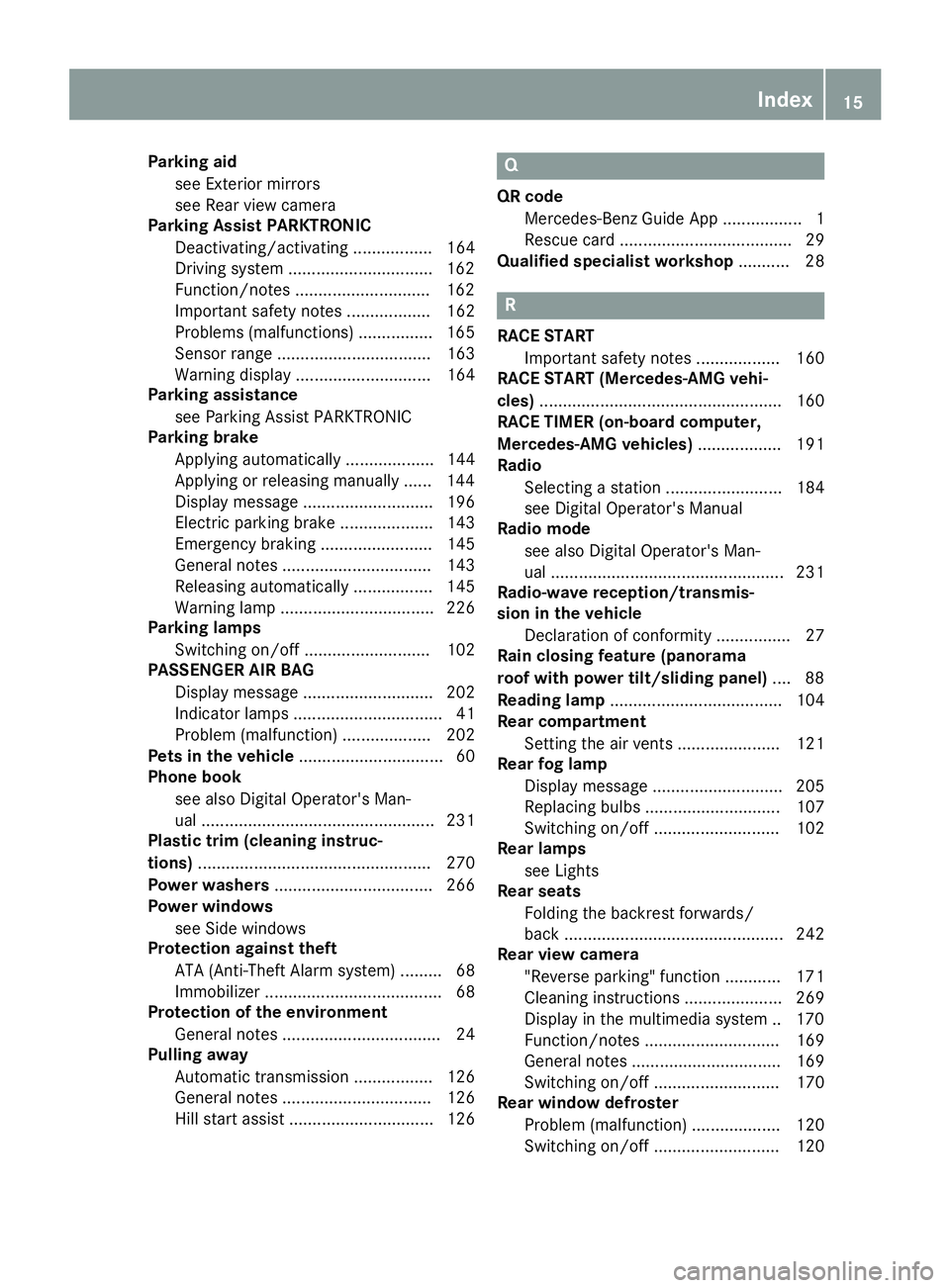
Parking aid
see Exterior mirrors
see Rear view camera
Parking Assist PARKTRONIC
Deactivating/activating ................. 164
Driving system ...............................162
Function/notes .............................162
Important safety notes .................. 162
Problems (malfunctions) ................ 165
Sensor range ................................. 163
Warning display............................. 164
Parking assistance
see Parking Assist PARKTRONIC
Parking brake
Applying automatically................... 144
Applying or releasing manually ...... 144
Display message ............................ 196
Electric parking brake .................... 143
Emergency braking ........................ 145
General notes ................................ 143
Releasing automatically................. 145
Warning lamp ................................. 226
Parking lamps
Switching on/off........................... 102
PASSENGER AIR BAG
Display message ............................ 202
Indicator lamps ................................ 41
Problem (malfunction) ................... 202
Pets in the vehicle............................... 60
Phone book
see also Digital Operator's Man-
ual .................................................. 231
Plastic trim (cleaning instruc-
tions).................................................. 270
Power washers.................................. 266
Power windows
see Side windows
Protection against theft
ATA (Anti-Theft Alarm system) ......... 68
Immobilizer ...................................... 68
Protection of the environment
General notes .................................. 24
Pulling away
Automatic transmission ................. 126
General notes ................................ 126
Hill start assist ............................... 126
Q
QR code
Mercedes-Benz Guide App ................. 1
Rescue card ..................................... 29
Qualified specialist workshop........... 28
R
RACE START
Important safety notes .................. 160
RACE START (Mercedes-AMG vehi-
cles).................................................... 160
RACE TIMER (on-board computer,
Mercedes-AMG vehicles).................. 191
Radio
Selecting a station ......................... 184
see Digital Operator's Manual
Radio mode
see also Digital Operator's Man-
ual .................................................. 231
Radio-wave reception/transmis-
sion in the vehicle
Declaration of conformity ................ 27
Rain closing feature (panorama
roof with power tilt/sliding panel).... 88
Reading lamp..................................... 104
Rear compartment
Setting the air vents ...................... 121
Rear fog lamp
Display message ............................ 205
Replacing bulbs............................. 107
Switching on/off........................... 102
Rear lamps
see Lights
Rear seats
Folding the backrest forwards/
back ............................................... 242
Rear view camera
"Reverse parking" function ............ 171
Cleaning instructions ..................... 269
Display in the multimedia system .. 170
Function/notes............................. 169
General notes ................................ 169
Switching on/off........................... 170
Rear window defroster
Problem (malfunction) ................... 120
Switching on/off........................... 120
Index15
Page 18 of 330
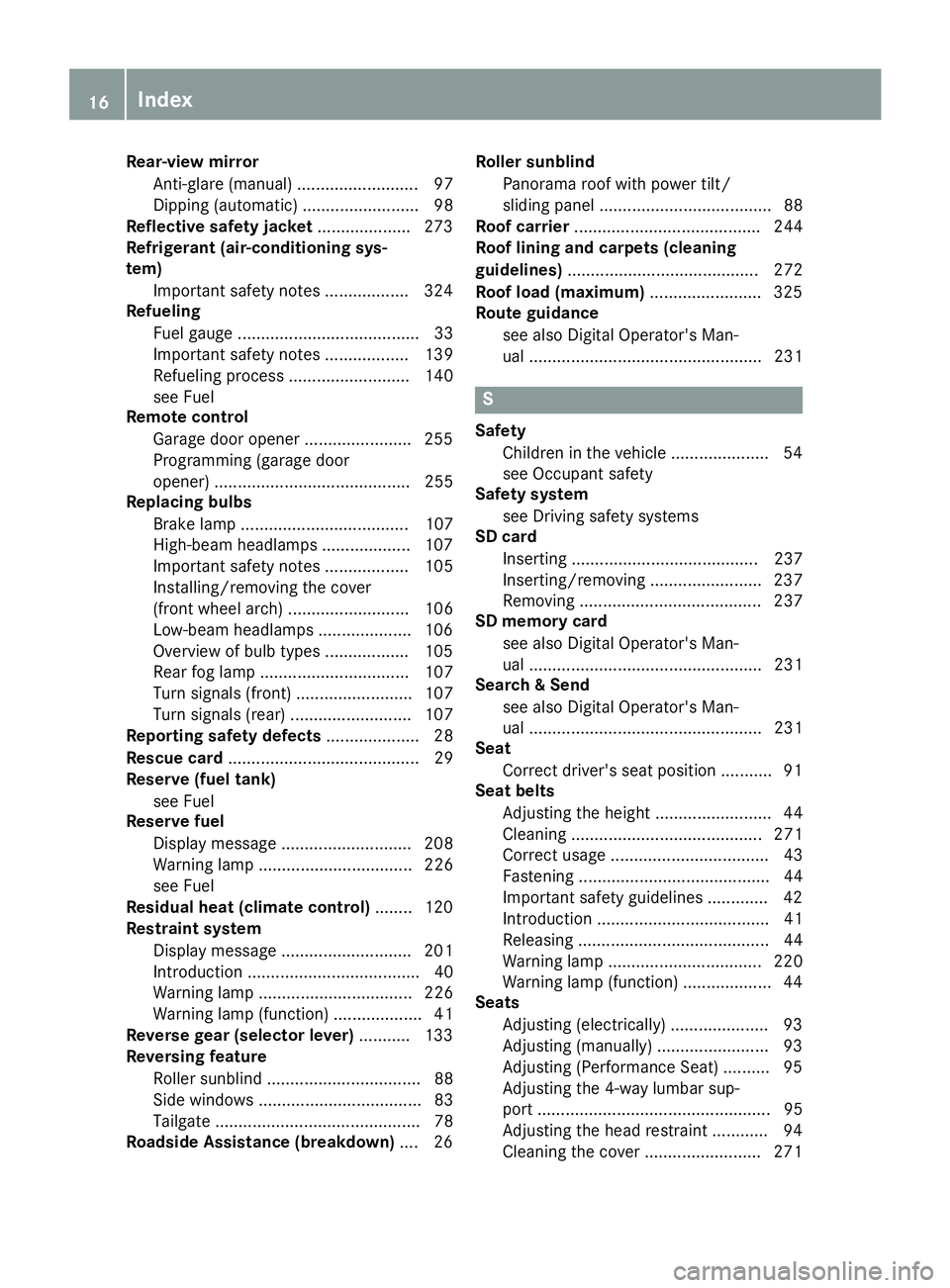
Rear-view mirror
Anti-glare (manual) .......................... 97
Dipping (automatic) ......................... 98
Reflective safety jacket.................... 273
Refrigerant (air-conditioning sys-
tem)
Important safety notes .................. 324
Refueling
Fuel gauge....................................... 33
Important safety notes .................. 139
Refueling process .......................... 140
see Fuel
Remote control
Garage door opener ....................... 255
Programming (garage door
opener) .......................................... 255
Replacing bulbs
Brake lamp .................................... 107
High-beam headlamps................... 107
Important safety notes .................. 105
Installing/removing the cover
(front wheel arch) .......................... 106
Low-beam headlamps.................... 106
Overview of bulb types .................. 105
Rear fog lamp ................................ 107
Turn signals (front) ......................... 107
Turn signals (rear) .......................... 107
Reporting safety defects.................... 28
Rescue card......................................... 29
Reserve (fuel tank)
see Fuel
Reserve fuel
Display message ............................ 208
Warning lamp ................................. 226
see Fuel
Residual heat (climate control)........ 120
Restraint system
Display message ............................ 201
Introduction ..................................... 40
Warning lamp ................................. 226
Warning lamp (function) ................... 41
Reverse gear (selector lever)........... 133
Reversing feature
Roller sunblind ................................. 88
Side windows ................................... 83
Tailgate ............................................ 78
Roadside Assistance (breakdown).... 26
Roller sunblind
Panorama roof with power tilt/
sliding panel ..................................... 88
Roof carrier........................................ 244
Roof lining and carpets (cleaning
guidelines)......................................... 272
Roof load (maximum)........................ 325
Route guidance
see also Digital Operator's Man-
ual .................................................. 231
S
Safety
Children in the vehicle ..................... 54
see Occupant safety
Safety system
see Driving safety systems
SD card
Inserting ........................................ 237
Inserting/removing ........................ 237
Removing ....................................... 237
SD memory card
see also Digital Operator's Man-
ual .................................................. 231
Search & Send
see also Digital Operator's Man-
ual .................................................. 231
Seat
Correct driver's seat position ........... 91
Seat belts
Adjusting the height ......................... 44
Cleaning ......................................... 271
Correct usage .................................. 43
Fastening ......................................... 44
Important safety guidelines ............. 42
Introduction ..................................... 41
Releasing ......................................... 44
Warning lamp ................................. 220
Warning lamp (function) ................... 44
Seats
Adjusting (electrically) ..................... 93
Adjusting (manually) ........................ 93
Adjusting (Performance Seat) .......... 95
Adjusting the 4-way lumbar sup-
port .................................................. 95
Adjusting the head restraint ............ 94
Cleaning the cover ......................... 271
16Index
Page 44 of 330
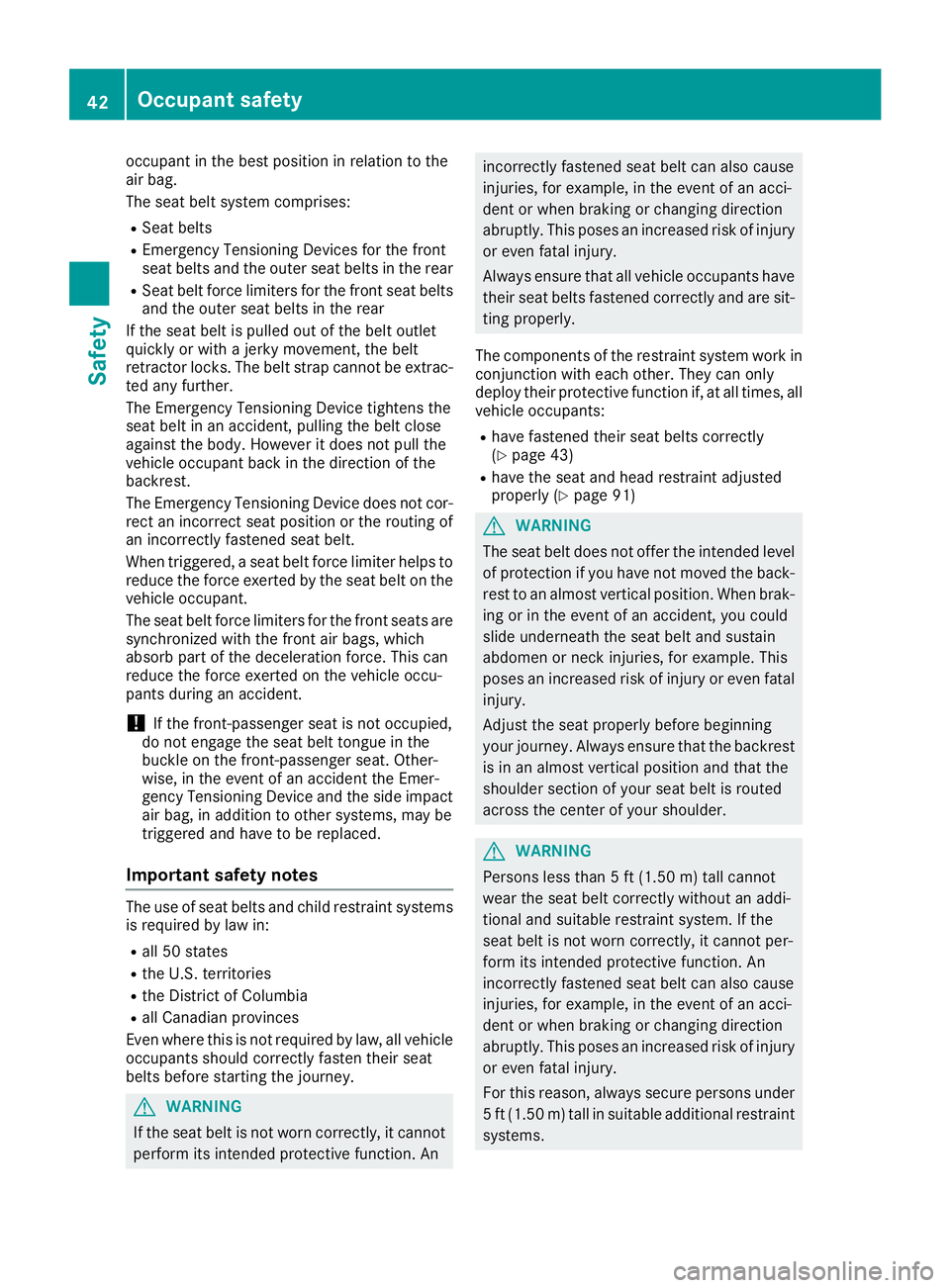
occupant in the best position in relation to theair bag.
The seat belt system comprises:
RSeat belts
REmergency Tensioning Devices for the frontseat belts and the outer seat belts in the rear
RSeat belt force limiters for the front seat beltsand the outer seat belts in the rear
If the seat belt is pulled out of the belt outletquickly or with a jerky movement, the beltretractor locks. The belt strap cannot be extrac-ted any further.
The Emergency Tensioning Device tightens theseat belt in an accident, pulling the belt closeagainst the body. However it does not pull thevehicle occupant back in the direction of thebackrest.
The Emergency Tensioning Device does not cor-rect an incorrect seat position or the routing ofan incorrectly fastened seat belt.
When triggered, a seat belt force limiter helps toreduce the force exerted by the seat belt on thevehicle occupant.
The seat belt force limiters for the front seats aresynchronized with the front air bags, whichabsorb part of the deceleration force. This canreduce the force exerted on the vehicle occu-pants during an accident.
!If the front-passenger seat is not occupied,do not engage the seat belt tongue in thebuckle on the front-passenger seat. Other-wise, in the event of an accident the Emer-gency Tensioning Device and the side impactair bag, in addition to other systems, may betriggered and have to be replaced.
Important safety notes
The use of seat belts and child restraint systemsis required by law in:
Rall 50 states
Rthe U.S. territories
Rthe District of Columbia
Rall Canadian provinces
Even where this is not required by law, all vehicleoccupants should correctly fasten their seatbelts before starting the journey.
GWARNING
If the seat belt is not worn correctly, it cannot
perform its intended protective function. An
incorrectly fastened seat belt can also cause
injuries, for example, in the event of an acci-
dent or when braking or changing direction
abruptly. This poses an increased risk of injury
or even fatal injury.
Always ensure that all vehicle occupants have
their seat belts fastened correctly and are sit-
ting properly.
The components of the restraint system work inconjunction with each other. They can onlydeploy their protective function if, at all times, allvehicle occupants:
Rhave fastened their seat belts correctly(Ypage 43)
Rhave the seat and head restraint adjustedproperly (Ypage 91)
GWARNING
The seat belt does not offer the intended level
of protection if you have not moved the back-
rest to an almost vertical position. When brak-
ing or in the event of an accident, you could
slide underneath the seat belt and sustain
abdomen or neck injuries, for example. This
poses an increased risk of injury or even fatal
injury.
Adjust the seat properly before beginning
your journey. Always ensure that the backrest
is in an almost vertical position and that the
shoulder section of your seat belt is routed
across the center of your shoulder.
GWARNING
Persons less than 5 ft (1.50 m) tall cannot
wear the seat belt correctly without an addi-
tional and suitable restraint system. If the
seat belt is not worn correctly, it cannot per-
form its intended protective function. An
incorrectly fastened seat belt can also cause
injuries, for example, in the event of an acci-
dent or when braking or changing direction
abruptly. This poses an increased risk of injury
or even fatal injury.
For this reason, always secure persons under
5 ft (1.50 m) tall in suitable additional restraint
systems.
42Occupant safety
Safety
Page 47 of 330
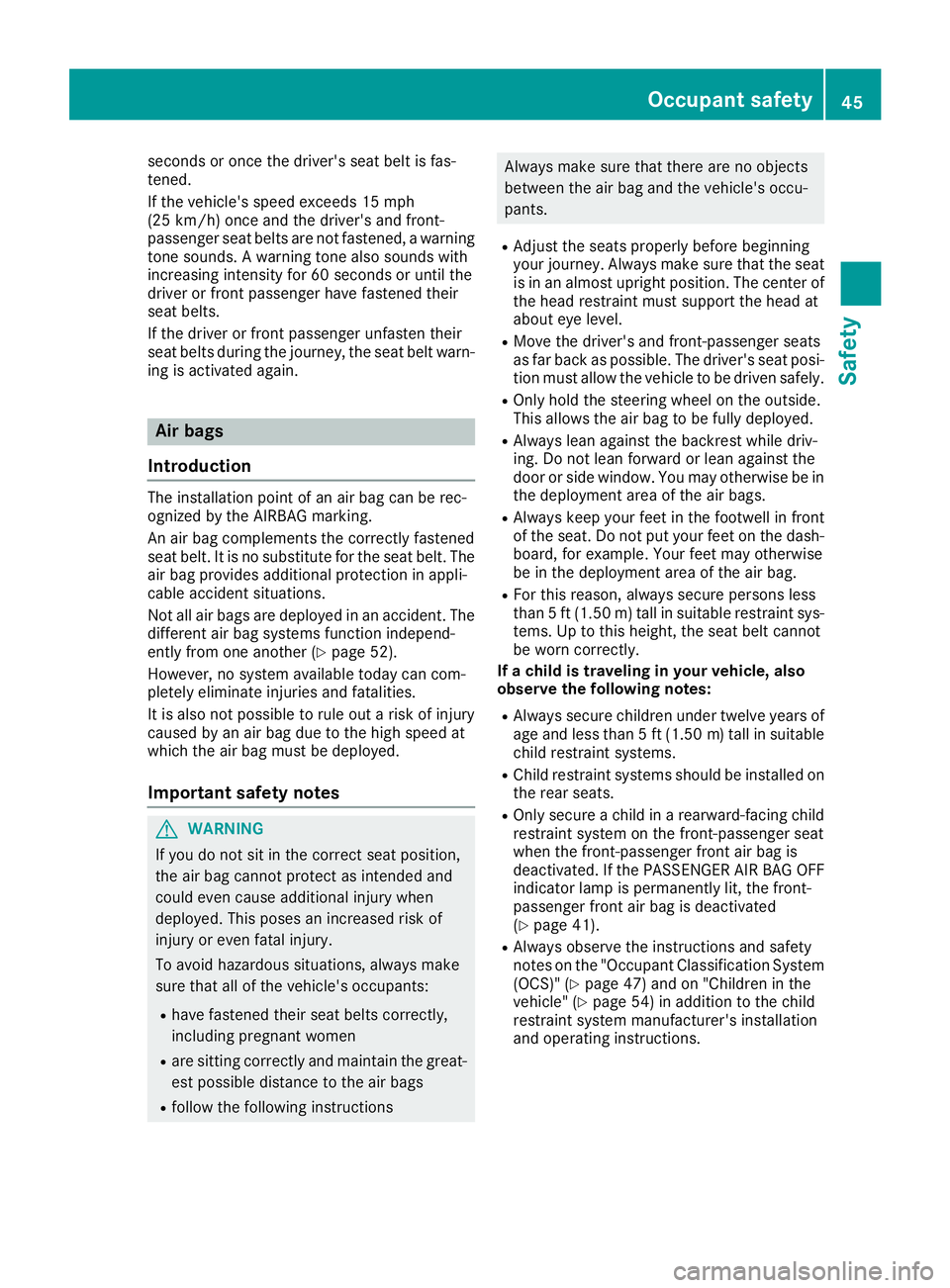
seconds or once the driver's seat belt is fas-tened.
If the vehicle's speed exceeds 15 mph(25 km/h) once and the driver's and front-passenger seat belts are not fastened, a warningtone sounds. A warning tone also sounds withincreasing intensity for 60 seconds or until thedriver or front passenger have fastened theirseat belts.
If the driver or front passenger unfasten theirseat belts during the journey, the seat belt warn-ing is activated again.
Air bags
Introduction
The installation point of an air bag can be rec-ognized by the AIRBAG marking.
An air bag complements the correctly fastenedseat belt. It is no substitute for the seat belt. Theair bag provides additional protection in appli-cable accident situations.
Not all air bags are deployed in an accident. Thedifferent air bag systems function independ-ently from one another (Ypage 52).
However, no system available today can com-pletely eliminate injuries and fatalities.
It is also not possible to rule out a risk of injurycaused by an air bag due to the high speed atwhich the air bag must be deployed.
Important safety notes
GWARNING
If you do not sit in the correct seat position,
the air bag cannot protect as intended and
could even cause additional injury when
deployed. This poses an increased risk of
injury or even fatal injury.
To avoid hazardous situations, always make
sure that all of the vehicle's occupants:
Rhave fastened their seat belts correctly,
including pregnant women
Rare sitting correctly and maintain the great-
est possible distance to the air bags
Rfollow the following instructions
Always make sure that there are no objects
between the air bag and the vehicle's occu-
pants.
RAdjust the seats properly before beginningyour journey. Always make sure that the seatis in an almost upright position. The center ofthe head restraint must support the head atabout eye level.
RMove the driver's and front-passenger seatsas far back as possible. The driver's seat posi-tion must allow the vehicle to be driven safely.
ROnly hold the steering wheel on the outside.This allows the air bag to be fully deployed.
RAlways lean against the backrest while driv-ing. Do not lean forward or lean against thedoor or side window. You may otherwise be inthe deployment area of the air bags.
RAlways keep your feet in the footwell in frontof the seat. Do not put your feet on the dash-board, for example. Your feet may otherwisebe in the deployment area of the air bag.
RFor this reason, always secure persons lessthan 5 ft (1.50 m) tall in suitable restraint sys-tems. Up to this height, the seat belt cannotbe worn correctly.
If a child is traveling in your vehicle, alsoobserve the following notes:
RAlways secure children under twelve years ofage and less than 5 ft (1.50m)tall in suitablechild restraint systems.
RChild restraint systems should be installed onthe rear seats.
ROnly secure a child in a rearward-facing childrestraint system on the front-passenger seatwhen the front-passenger front air bag isdeactivated. If the PASSENGER AIR BAG OFFindicator lamp is permanently lit, the front-passenger front air bag is deactivated(Ypage 41).
RAlways observe the instructions and safetynotes on the "Occupant Classification System(OCS)" (Ypage 47) and on "Children in thevehicle" (Ypage 54) in addition to the childrestraint system manufacturer's installationand operating instructions.
Occupant safety45
Safety
Z
Page 48 of 330
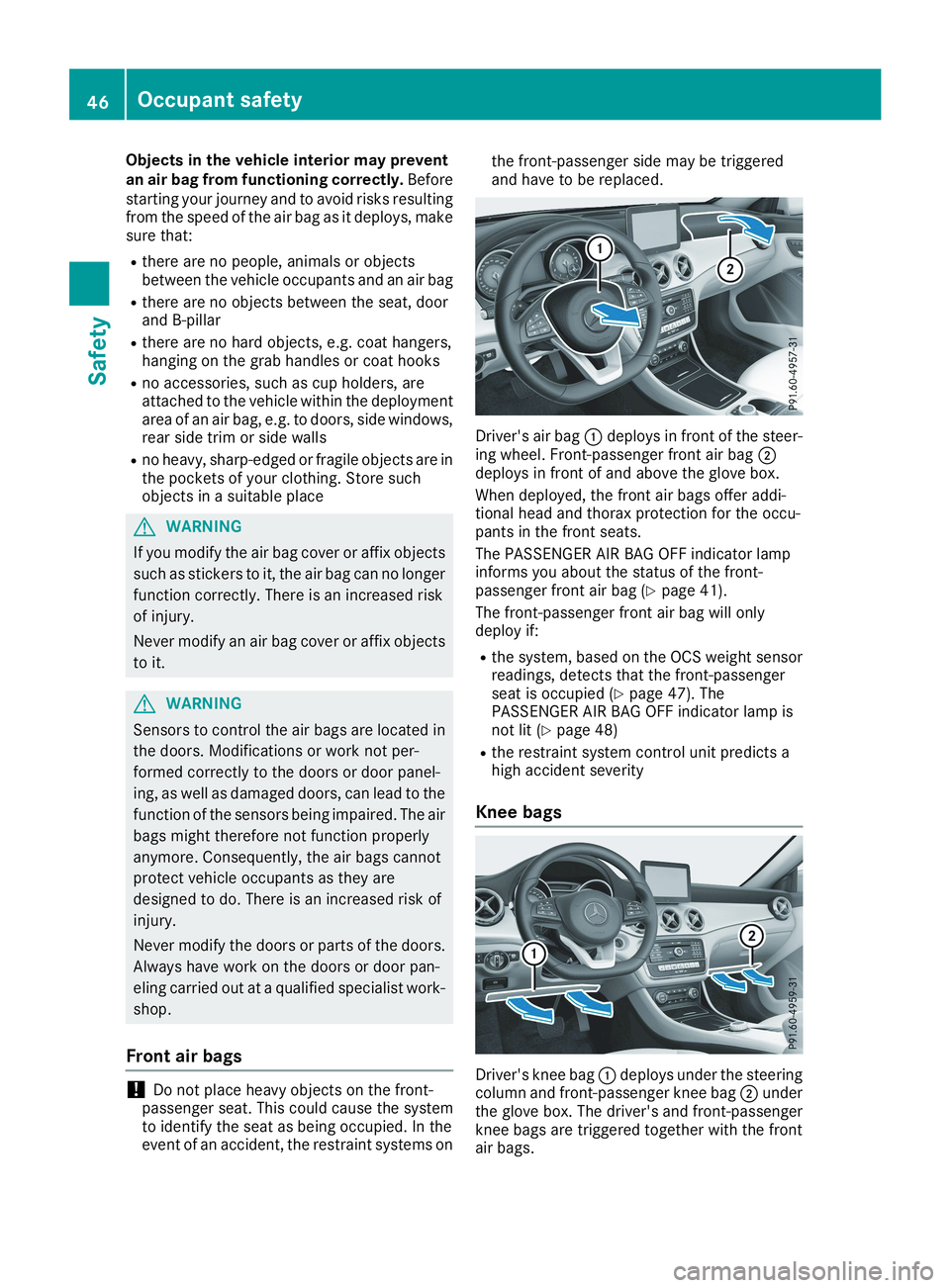
Objects in the vehicle interior may preventan air bag from functioning correctly.Beforestarting your journey and to avoid risks resultingfrom the speed of the air bag as it deploys, makesure that:
Rthere are no people, animals or objectsbetween the vehicle occupants and an air bag
Rthere are no objects between the seat, doorand B-pillar
Rthere are no hard objects, e.g. coat hangers,hanging on the grab handles or coat hooks
Rno accessories, such as cup holders, areattached to the vehicle within the deploymentarea of an air bag, e.g. to doors, side windows,rear side trim or side walls
Rno heavy, sharp-edged or fragile objects are inthe pockets of your clothing. Store suchobjects in a suitable place
GWARNING
If you modify the air bag cover or affix objects
such as stickers to it, the air bag can no longer
function correctly. There is an increased risk
of injury.
Never modify an air bag cover or affix objects
to it.
GWARNING
Sensors to control the air bags are located in
the doors. Modifications or work not per-
formed correctly to the doors or door panel-
ing, as well as damaged doors, can lead to the
function of the sensors being impaired. The air
bags might therefore not function properly
anymore. Consequently, the air bags cannot
protect vehicle occupants as they are
designed to do. There is an increased risk of
injury.
Never modify the doors or parts of the doors.
Always have work on the doors or door pan-
eling carried out at a qualified specialist work-
shop.
Front air bags
!Do not place heavy objects on the front-passenger seat. This could cause the systemto identify the seat as being occupied. In theevent of an accident, the restraint systems on
the front-passenger side may be triggeredand have to be replaced.
Driver's air bag�Cdeploys in front of the steer-ing wheel. Front-passenger front air bag�Ddeploys in front of and above the glove box.
When deployed, the front air bags offer addi-tional head and thorax protection for the occu-pants in the front seats.
The PASSENGER AIR BAG OFF indicator lampinforms you about the status of the front-passenger front air bag (Ypage 41).
The front-passenger front air bag will onlydeploy if:
Rthe system, based on the OCS weight sensorreadings, detects that the front-passengerseat is occupied (Ypage 47). ThePASSENGER AIR BAG OFF indicator lamp isnot lit (Ypage 48)
Rthe restraint system control unit predicts ahigh accident severity
Knee bags
Driver's knee bag�Cdeploys under the steeringcolumn and front-passenger knee bag�Dunderthe glove box. The driver's and front-passengerknee bags are triggered together with the frontair bags.
46Occupant safety
Safety
Page 49 of 330
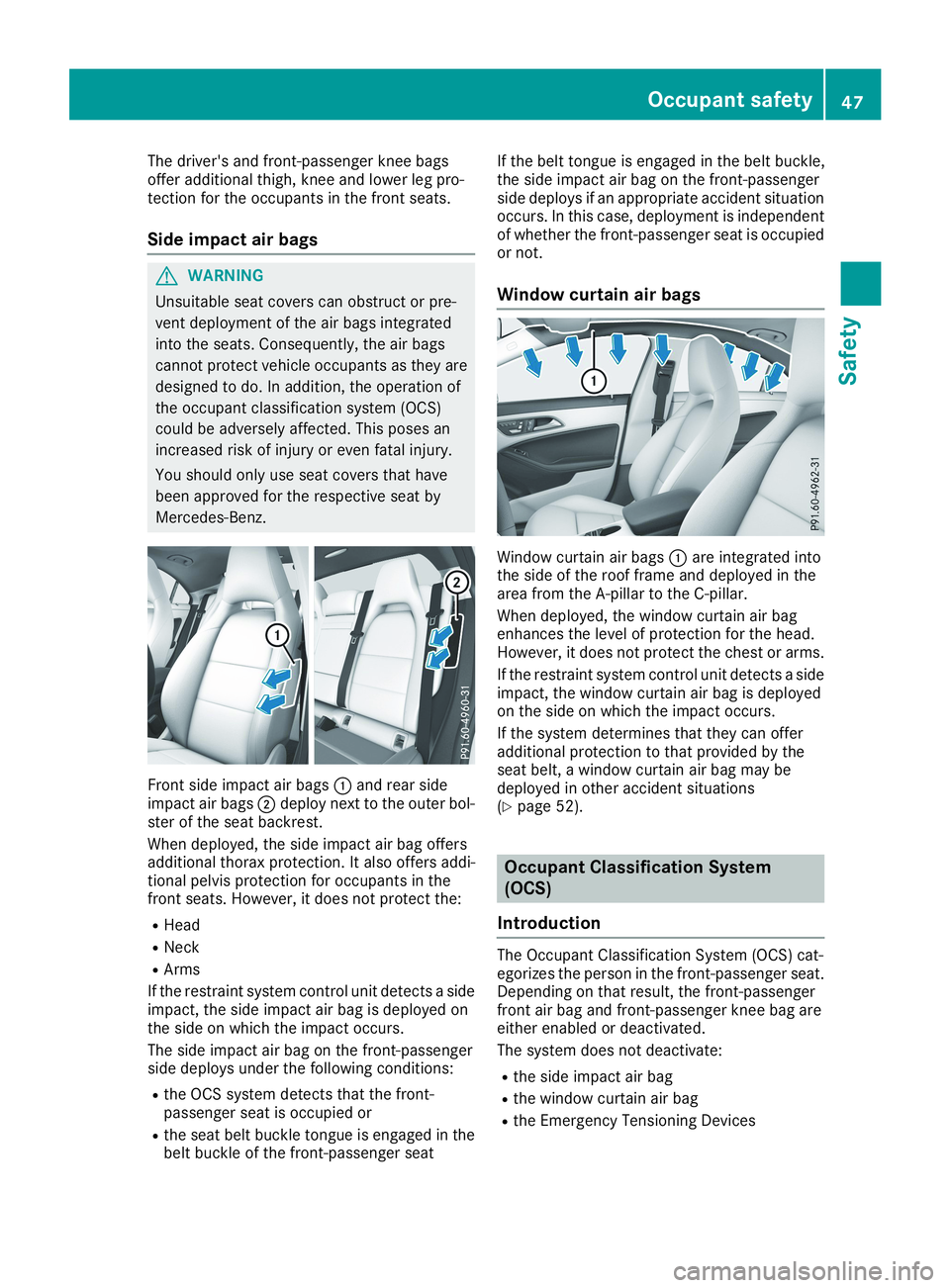
The driver's and front-passenger knee bagsoffer additional thigh, knee and lower leg pro-tection for the occupants in the front seats.
Side impact air bags
GWARNING
Unsuitable seat covers can obstruct or pre-
vent deployment of the air bags integrated
into the seats. Consequently, the air bags
cannot protect vehicle occupants as they are
designed to do. In addition, the operation of
the occupant classification system (OCS)
could be adversely affected. This poses an
increased risk of injury or even fatal injury.
You should only use seat covers that have
been approved for the respective seat by
Mercedes-Benz.
Front side impact air bags�Cand rear sideimpact air bags�Ddeploy next to the outer bol-ster of the seat backrest.
When deployed, the side impact air bag offersadditional thorax protection. It also offers addi-tional pelvis protection for occupants in thefront seats. However, it does not protect the:
RHead
RNeck
RArms
If the restraint system control unit detects a sideimpact, the side impact air bag is deployed onthe side on which the impact occurs.
The side impact air bag on the front-passengerside deploys under the following conditions:
Rthe OCS system detects that the front-passenger seat is occupied or
Rthe seat belt buckle tongue is engaged in thebelt buckle of the front-passenger seat
If the belt tongue is engaged in the belt buckle,the side impact air bag on the front-passengerside deploys if an appropriate accident situationoccurs. In this case, deployment is independentof whether the front-passenger seat is occupiedor not.
Window curtain air bags
Window curtain air bags�Care integrated intothe side of the roof frame and deployed in thearea from the A-pillar to the C-pillar.
When deployed, the window curtain air bagenhances the level of protection for the head.However, it does not protect the chest or arms.
If the restraint system control unit detects a sideimpact, the window curtain air bag is deployedon the side on which the impact occurs.
If the system determines that they can offeradditional protection to that provided by theseat belt, a window curtain air bag may bedeployed in other accident situations(Ypage 52).
Occupant Classification System
(OCS)
Introduction
The Occupant Classification System (OCS) cat-egorizes the person in the front-passenger seat.Depending on that result, the front-passengerfront air bag and front-passenger knee bag areeither enabled or deactivated.
The system does not deactivate:
Rthe side impact air bag
Rthe window curtain air bag
Rthe Emergency Tensioning Devices
Occupant safety47
Safety
Z
Page 56 of 330
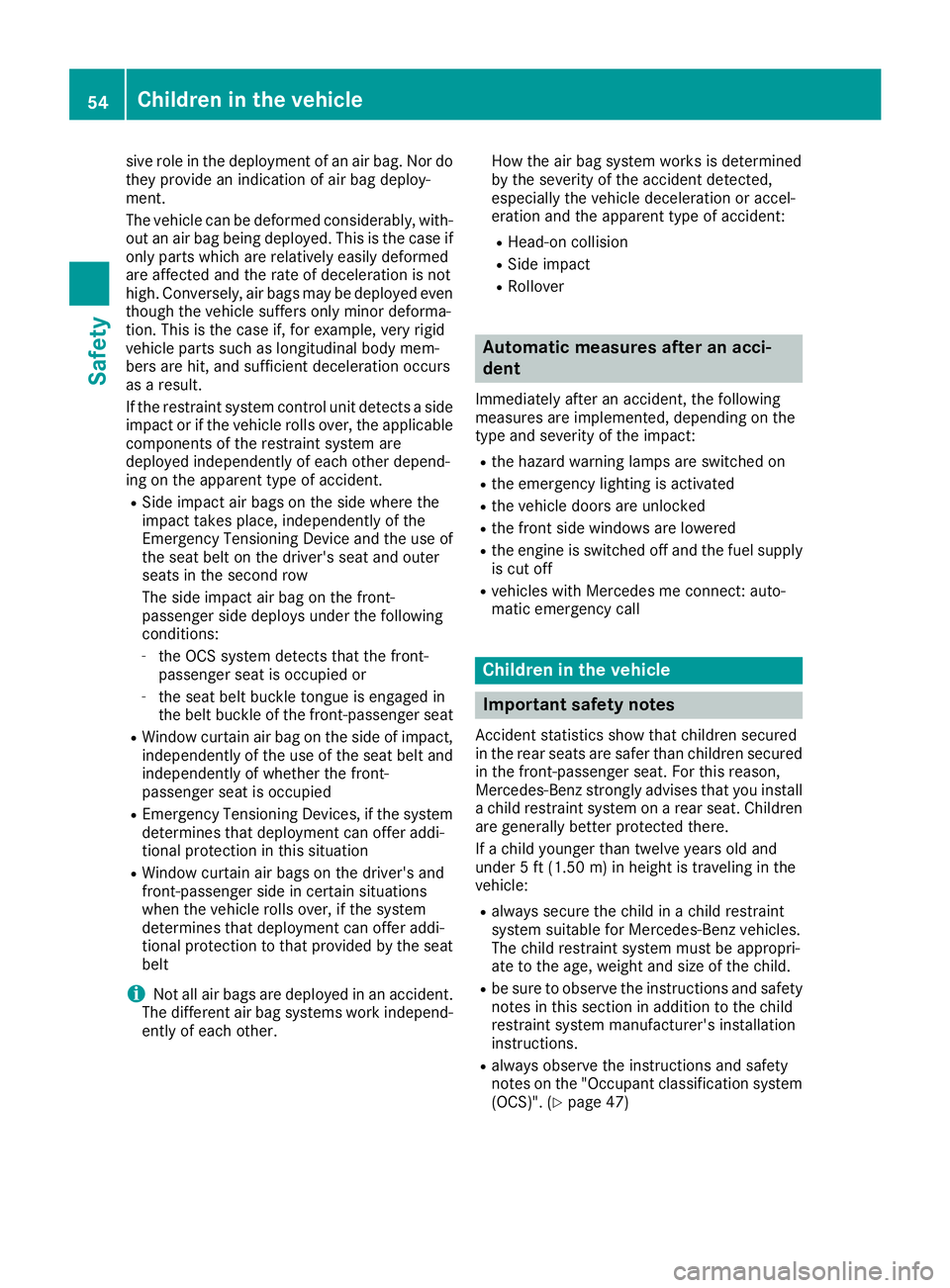
sive role in the deployment of an air bag. Nor dothey provide an indication of air bag deploy-ment.
The vehicle can be deformed considerably, with-out an air bag being deployed. This is the case ifonly parts which are relatively easily deformedare affected and the rate of deceleration is nothigh. Conversely, air bags may be deployed eventhough the vehicle suffers only minor deforma-tion. This is the case if, for example, very rigidvehicle parts such as longitudinal body mem-bers are hit, and sufficient deceleration occursas a result.
If the restraint system control unit detects a sideimpact or if the vehicle rolls over, the applicablecomponents of the restraint system aredeployed independently of each other depend-ing on the apparent type of accident.
RSide impact air bags on the side where theimpact takes place, independently of theEmergency Tensioning Device and the use ofthe seat belt on the driver's seat and outerseats in the second row
The side impact air bag on the front-passenger side deploys under the followingconditions:
-the OCS system detects that the front-passenger seat is occupied or
-the seat belt buckle tongue is engaged inthe belt buckle of the front-passenger seat
RWindow curtain air bag on the side of impact,independently of the use of the seat belt andindependently of whether the front-passenger seat is occupied
REmergency Tensioning Devices, if the systemdetermines that deployment can offer addi-tional protection in this situation
RWindow curtain air bags on the driver's andfront-passenger side in certain situationswhen the vehicle rolls over, if the systemdetermines that deployment can offer addi-tional protection to that provided by the seatbelt
iNot all air bags are deployed in an accident.The different air bag systems work independ-ently of each other.
How the air bag system works is determinedby the severity of the accident detected,especially the vehicle deceleration or accel-eration and the apparent type of accident:
RHead-on collision
RSide impact
RRollover
Automatic measures after an acci-
dent
Immediately after an accident, the followingmeasures are implemented, depending on thetype and severity of the impact:
Rthe hazard warning lamps are switched on
Rthe emergency lighting is activated
Rthe vehicle doors are unlocked
Rthe front side windows are lowered
Rthe engine is switched off and the fuel supplyis cut off
Rvehicles with Mercedes me connect: auto-matic emergency call
Children in the vehicle
Important safety notes
Accident statistics show that children securedin the rear seats are safer than children securedin the front-passenger seat. For this reason,Mercedes-Benz strongly advises that you installa child restraint system on a rear seat. Childrenare generally better protected there.
If a child younger than twelve years old andunder 5 ft (1.50 m) in height is traveling in thevehicle:
Ralways secure the child in a child restraintsystem suitable for Mercedes-Benz vehicles.The child restraint system must be appropri-ate to the age, weight and size of the child.
Rbe sure to observe the instructions and safetynotes in this section in addition to the childrestraint system manufacturer's installationinstructions.
Ralways observe the instructions and safetynotes on the "Occupant classification system(OCS)". (Ypage 47)
54Children in the vehicle
Safety